A glimpse of the ‘grey ghost’: spotting snow leopards in Ladakh
Simply sign up to the Life & Arts myFT Digest -- delivered directly to your inbox.
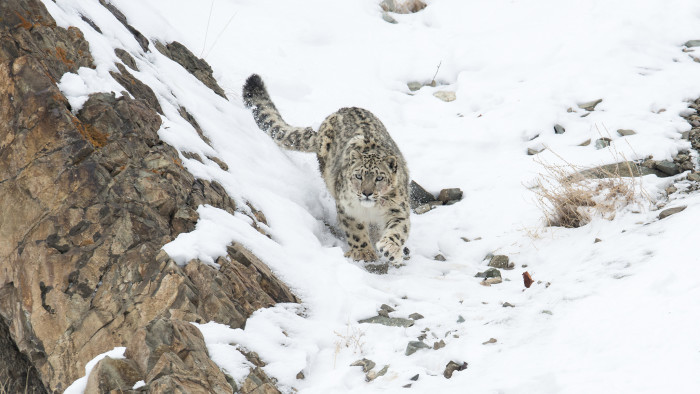
This piece had written itself before I’d even left the UK. I would fly into Ladakh, the high desert in the far north of the Indian Himalayas, and spend a week among its remote peaks in the depths of frigid winter, hunting for the creature known hereabouts as the “grey ghost of the mountains”, the snow leopard.
It is a crepuscular hunter so rare and elusive that wildlife film-makers rely on footage sprung by camera traps, and the author Peter Matthiessen spent two months in Nepal walking 250 miles looking in vain for one. So, after a week of fruitless searching — there are thought to be only between 100 and 300 snow leopards left in Ladakh, an area the size of Scotland — I would perhaps catch a fleeting glance of something, high on the ridgeline. Was that . . ? Could it have been . . ? And I would leave Ladakh, often called “Little Tibet”, with its prayer flags and gompas, having chased only shadows, meditating on the journey being the thing, not the destination, and finishing with a quote from Matthiessen’s 1978 classic The Snow Leopard: “I am not disappointed . . . that its frosty eyes watch us from the mountain — that is enough.”
“Kill,” said Norboo Tsewang, a farmer who, minutes earlier, had welcomed us to his homestay in the hamlet of Ulley, the base for our wild ghost chase. He was pointing to a telescope. One of my fellow guests lowered his head to the eyepiece. “They’ve put a stuffed snow leopard next to a dead yak,” he said to me. “Do you think it’s some kind of lure?”
I took a look. The stuffed snow leopard, lying about half a mile away, yawned, swished its long tail, then started chewing on the yak, which looked as if it had exploded, its throat torn open, its exposed crimson ribs glowing against the bleak, monochrome slopes. It was so impossible that for a second I thought it must be advanced animatronics. But no. The leopard got up and chased away some magpies, then flailed with a huge paw at a golden eagle that swooped low over the kill, and lay down again to resume eating, its left eye closed tightly shut, damaged in the hunt, so that it looked as if it was winking at me. “Bet you didn’t expect this, huh?” it seemed to be saying. “I’ve ruined your story.”
“Her name is Gyamo,” said Payal Mehta, 33, our Indian guide. “It means ‘Queen’ in Ladakhi. The locals have seen her a few times, high on the mountain, but not like this. Isn’t she beautiful?”
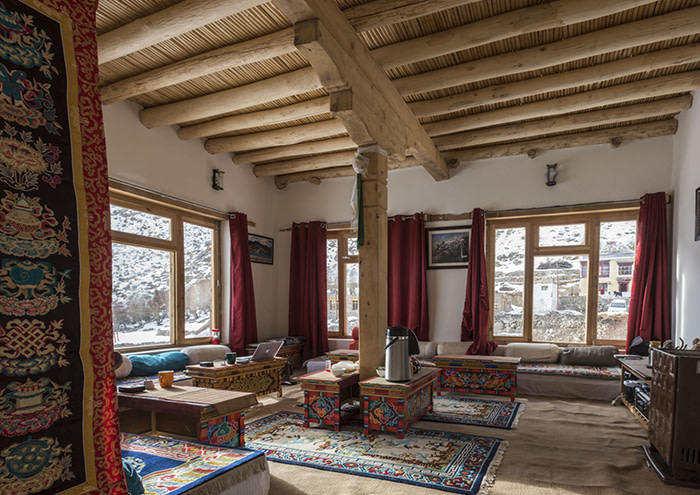
I looked back through the scope. She filled the frame, and I could clearly see the large, black rosettes on her short, stocky, smoky grey body, perfect camouflage for the terrain. She had tiny round ears to minimise heat loss in the freezer she called home, large nostrils to help her breathe the thin air, wide paws for walking on snow and a long, fat tail — over half her body length — which, as well as being used for balance, chasing prey down cliff faces, she would wrap around herself for warmth, like a stole. “Beautiful” somehow seemed an inadequate word.
“She is perfectly adapted for this terrain,” said Payal. Unlike me. I’d been holding my breath in the excitement of looking at Gyamo through the scope, and as I tried to gulp down some air, I found that my lungs, at 4,500 metres, had acquired the elasticity of punctured balloons.
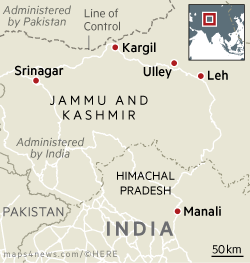
As the sun set behind the ice-bound 6,000-metre peaks, and the temperature plunged to -10C in a what seemed a heartbeat, we left Gyamo to her supper and headed off to ours in Norboo’s lodge, built in the typical Ladakhi vernacular, with roof beams of poplar and interstices of willow, the only two trees that can grow up here, and with a roof of compressed dirt for insulation.
Over chana masala and mutton paneer, served with khamber, the traditional Ladakhi bread, cooked by Norboo’s wife Dorma over an open yak-dung-burning fire in the yard, Norboo, 46, told me about his life-long passion for snow leopards. “When I see one, it feels as if my body is taken over by a spirit and I am going to fly,” he said.
Like him, Norboo’s father and grandfather raised yaks and goats here in Ulley, about 40 miles west of Ladakh’s capital, Leh. They lost a lot of animals to snow leopards and wolves. His grandfather, like most herders in these mountains, had killed plenty of the despised leopards. His father, “a docile man”, hadn’t killed them, but didn’t comprehend his son’s love for the big cats. “He died last year and up to his last breath he couldn’t understand why I protected them,” Norboo said.
Climate change was making life increasingly tough for the snow leopard, Norboo said. A World Wildlife Fund report from 2015 said the plants relied on by the leopard’s prey species — the wild Himalayan blue sheep, urials and ibex — were unable to survive in the higher temperatures. The decline in natural prey was resulting in more leopard attacks on livestock. Also, as the Earth warmed up, snow leopard territory previously uninhabitable for humans was being encroached upon.
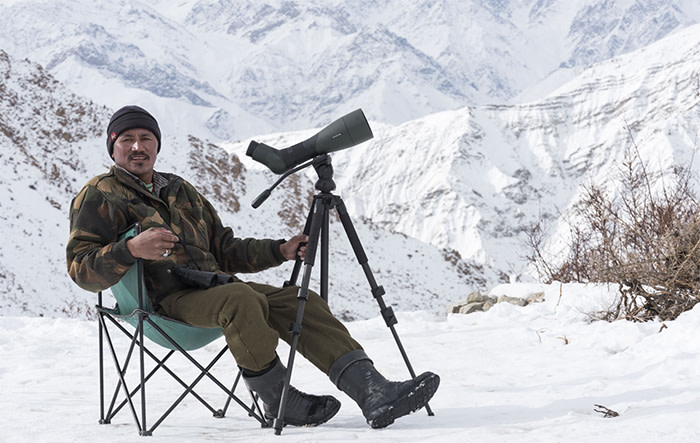
Pastoralism was also getting tougher with climate change, Norboo told me, so when he took over the farm in 2012, he combined herding with snow leopard tourism, throwing all of his savings into building eight guest bedrooms. Working under advice from the Snow Leopard Conservancy India Trust in Leh, he persuaded neighbouring farmers to spread wire mesh over their animal pens, which reduced attacks by snow leopards by 90 per cent. A community fund was started, with 10 per cent of all revenue from snow leopard tourism going into it. Previously, farmers drove snow leopards off their kills, but now that they were being compensated for the loss through the fund, they’d allow them to eat. Like Gyamo? Norboo nodded.
He now employs other local farmers and villagers, as cooks, as spotters and as guides. Numerous homestays throughout the valleys are doing the same thing. So everybody now benefits economically from keeping the snow leopards alive.
After a night of altitude-induced sleep deprivation, we ate a breakfast of garam masala omelettes and salty, greasy yak-butter tea, our faces puffy and swollen from the thin air so that we looked like boxers. Afterwards, we returned to see Gyamo, whose left eye looked less swollen, and who had got through a lot of yak overnight.
“Her two cubs have recently weaned,” Payal said. “They are probably nearby but if they tried to get some food now, she’d fight them for it.”
Seeing Gyamo so soon and so clearly liberated us. We’d won the lottery with our very first ticket. So instead of spending our days staring intensely at the rocky slopes for the merest flicker of life, we could relax and zoom out.
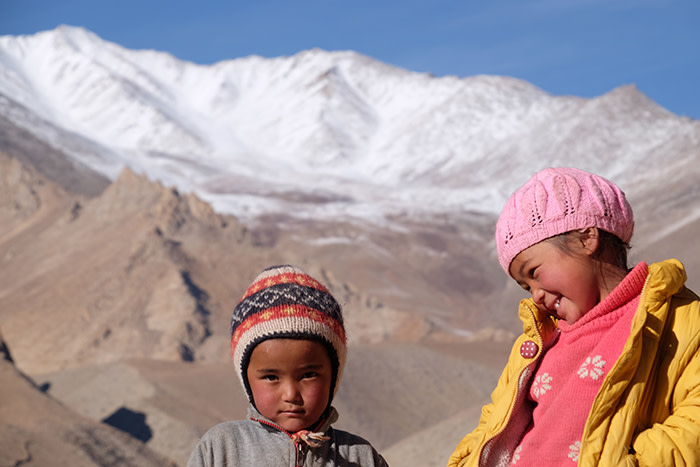
We set off to explore the area, driving down the dirt road from Norboo’s little village, with vertiginous drops to the valley below and the Ulley River a thin ribbon of buckled ice. We saw Tibetan snowcocks and clouds of red-billed choughs. Lammergeiers soared above us. We’d stop and sniff rocks as Payal pointed out dark stains, the scent markings of snow leopards, which smelled like stale, fermented alcohol. We examined the fresh tracks of wolves and their scat, bullets of hair and bone shards. Payal told us that wolves were still persecuted here: villagers would use tethered goats to lure them into deep wells, where they would be stoned to death.
We drove along the eerily quiet Srinagar-Leh highway. I’d never experienced an Indian main road as deserted and relaxing as that before. From September to May, snow blocks the high passes and Ladakh is in effect cut off from the world. Only opened to tourists in 1974, Ladakh has experienced a surge in visitors in recent years, helped in large part by interest generated by 3 idiots, a Bollywood movie shot here in 2009. Arrivals rose from 77,800 in 2010 to 236,000 (of which 38,000 were foreigners) in 2016, a spike that has raised concerns over water consumption in this arid landscape. In the cold months, though, when the only way in is by air, tourists remain a rarity — amounting to no more than a couple of thousand arrivals over the entire winter.
The only other vehicles on the road were army trucks — a third of India’s armed forces are based in the wider region — a reminder of Ladakh’s proximity to China and the disputed border with Pakistan.
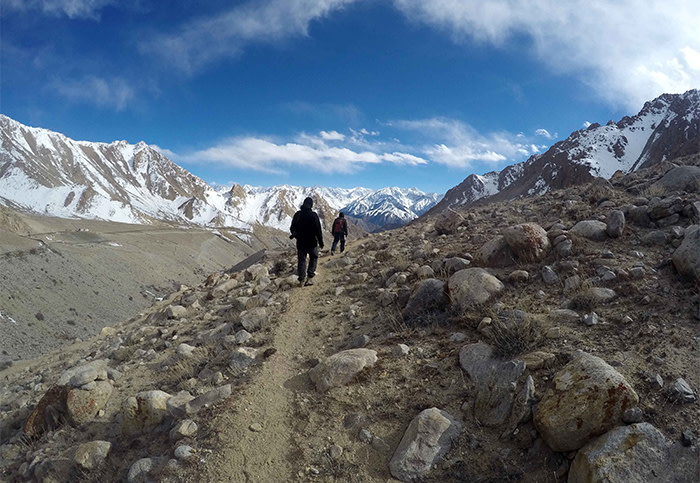
Under a fierce sun, we followed the mighty Indus, its water the unnatural bright blue of toothpaste and bobbing with chunks of ice. We drove over passes where tattered prayer flags whip-cracked in the biting wind, passed monasteries shuttered up for the winter, and through remote villages above which huge golden Buddhas sat on hilltops gazing benevolently down. All around us were dusty, khaki-coloured slopes, deprived of India’s monsoons by being in the rain shadow of the high mountains to the south. There were wind-eroded pinnacles and rocks fretted into grotesque forms, cliffs of brilliant pink and green and maroon, painted by the minerals within, under which we’d stop for cups of kahwa, the local saffron tea with crushed almonds. As we drank, our spotters pointed out herds of wild urials and blue sheep impossibly making their way up the sheer faces of rock above.
After dinner back at Norboo’s, I would put on every item of clothing I had and venture out into the freezing night. Whether it was the thin air this high up, or the total lack of light pollution for miles around, the skies were beyond compare — black velvet upon which a giant hand had sprinkled diamond dust.
On our last day, we returned to see Gyamo, but she had gone, the carcass now attended by half a dozen Himalayan griffon vultures, shoulders stooped like old men, tearing off the few remaining bits of the yak. They flew off — was there ever a creature so ugly on the ground yet so beautiful in flight? — and the golden eagles moved in, then the foxes, then the magpies for the crumbs, till only the bones remained. We had seen the whole ecology of the kill: the dynamic loop of death and life, from the grass to the yak to Gyamo to the birds; all that energy now dispersed all over these mountains.
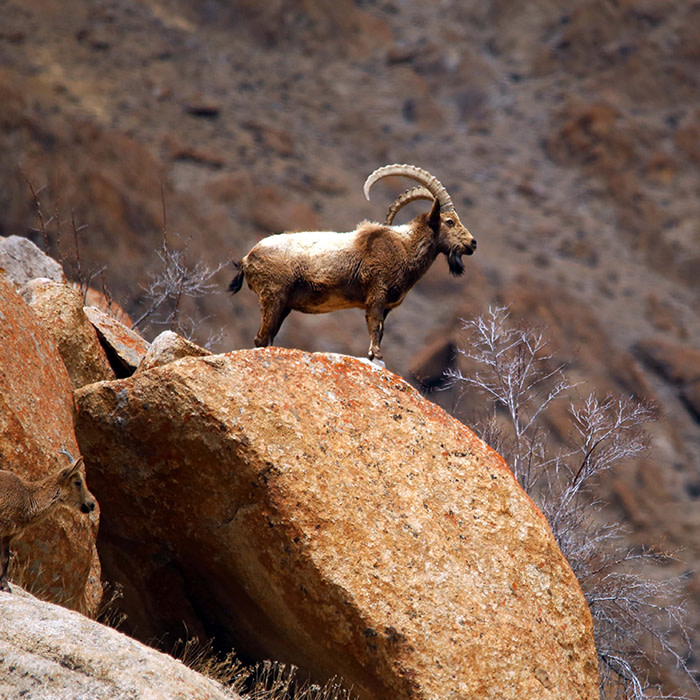
One of the spotters was pointing to the ridgeline high above. There was a lone male ibex, in classic silhouette, its immense vaulted horns like a pharaoh’s headdress. One of the other spotters, looking down the mountain, beckoned me over. “Look, look,” he said, excitedly. I put my eye to the scope. This was the part in my original story where the snow leopard would have appeared. But it wasn’t a cat. It was a large Tibetan wolf, walking slowly up the hill towards us.
Norboo thought she was the lone survivor of a pack that had been killed recently by villagers nearby. “I think she will survive, find a mate and create a new pack,” he whispered. “I’m confident I will hear her calling come spring.”
She walked barely 100 yards away from us. Nobody dared to breathe. Then she headed up the scree slope, moving lightly, as if her paws weren’t touching the ground, like she was flowing over the earth, free, noble, imperious.
Can you upstage a snow leopard? I’m not sure. But it was mighty close.
Details
Mike Carter was a guest of AndBeyond. Its 13-day day Snow Leopard Expedition costs from $6,920 per person, including all meals, internal flights, a night in Delhi and all activities, guiding and entrance fees in Ladakh. British Airways (ba.com) flies twice a day from London to Delhi, from £440 return
Follow @FTLifeArts on Twitter to find out about our latest stories first. Subscribe to FT Life on YouTube for the latest FT Weekend videos
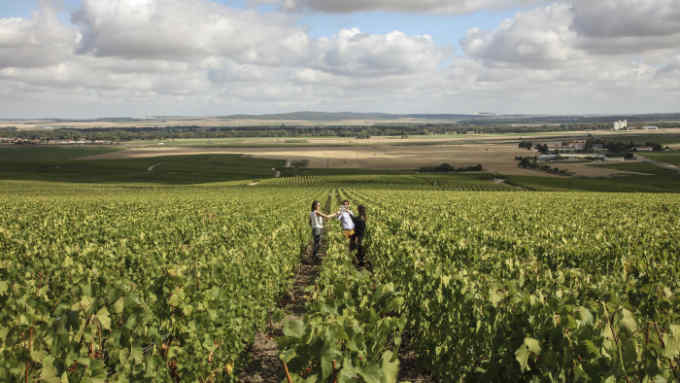
Comments